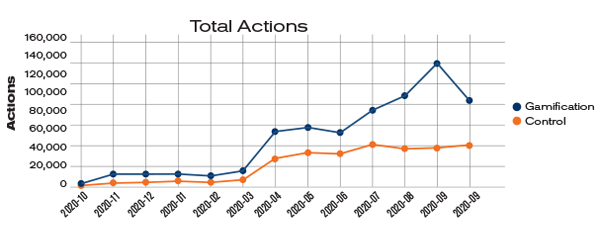The seven principles of a successful gamification program
Written by: Lea Sorrentino, VP Bunchball; Neil Helgeson, Director, Insights Lab; Barry Danielson, VP, Decision Sciences
(View Author Bio)
A persistent misconception surrounding gamification in the workplace is that it means introducing games or turning tasks into games. In reality, true gamification is the process of incorporating game-like elements into non-game contexts and tapping into the psychological drivers that make games engaging to motivate employees and customers.

Here are 7 principles we employ on projects that use gamification to drive results.
1. Work should be interesting and engaging.
The base game mechanic is working toward a goal, and the best games make that goal personal and easy to follow. There is no gamification without goal setting. In the workplace, our research shows employees who set goals are 6.5x more likely to stay at their job.
Think about what draws you to your favorite gaming experience. Maybe it’s being engaged in a world; maybe it’s the dopamine hit you get when you clear a level; maybe it’s the feeling of being on top of the world when you finally reach that high score.
Whatever the case, we believe the mechanics that make games interesting and engaging should be applied to work environments. Game techniques can inspire people to solve problems by guiding their behavior and getting them excited about their contributions. We want to transform the way people work, making it more enjoyable and more productive.
Those examples above are instances of intrinsic motivation and the five core motivators of any successful gamification initiative are:
-
Autonomy
-
Purpose
-
Progress
-
Mastery
-
Social
We often tell our clients to gamify their goals, not their platform. Tying mechanics to a desired outcome is essential to driving results. Each of those five motivators can be applied to a given situation, and as we work through the next six principles we will explain where and how each one fits in.
2. People want to contribute to their community.
As humans, we have an innate desire to be part of something bigger than ourselves—to have a sense of purpose. That sense of social community is facilitated through group belonging and cooperation. As sporting events often show, friendly rivalries between communities can be a powerful tool for engagement, and research shows employees who are given regular opportunities to check their standing with a supervisor are 5x more likely to say, “working here is inspiring.”
3. Accomplishments are habit-forming. Recognize more accomplishments to form more habits.
The broadest goal of a game might be to save the princess or get to the center of the solar system, but without clear milestones and objectives along the way it can become paralyzing to decide what to do first, second and so-forth. That’s why game designers use levels, checkpoints and checklists to guide progress, and the best designers use progressive course design to drip-feed skills and actions to players along the way.
We want to turn actions into habit. By incenting behaviors with intrinsic motivators and extrinsic rewards, it becomes second nature to overcome challenges and master tasks. We believe that small, consistent behavioral improvements lead to large organizational outcomes.
In a recent case study with a client looking to drive engagement in their learning platform, we worked with them to develop a set of program rules and a series of educational missions to break up larger learning objectives and drive engagement. By bite-sizing modules and introducing more manageable progress goals, we boosted participation from 50% to 80%.
4. Creativity and curiosity are empowering.
The most popular modern gaming experiences eschew linear structures and offer an open-world, non-linear experience. People are naturally drawn to curiosity, unpredictability and a desire for autonomy. In the workplace, we satisfy this with meaningful choices and personalized paths to achieve success. In a journey of purpose and meaning, there should never be one standard way to “win.”
5. Goals should be transparent.
Employees who know how their goals connect to the larger picture feel more inspired and are more committed. They are:
10x more likely to be motivated to take action at work
7.9x more likely to feel proud to work at their organization
6.8x more likely to recommend their organization to others
8.9x more likely to say "my job matters"
7.2x more likely to value the organization's mission
But 23% of employees say they don’t know how achieving their goals impacts the success of their organization. Putting goal structure and reward opportunity where work happens puts value and motivation in front of your customers, employees and partners. Those experiences should be mutually and clearly beneficial—it’s essential to be open about the intent of a program so users know how and why they are participating.
6. Show your work.
Back in 2005, with the launch of their Xbox 360, Microsoft introduced a new iteration on the classic high scores table with their achievements system. Whenever a player accomplishes a goal in a game, all of their friends are instantaneously notified via a small popup at the bottom of the screen no matter what game they happen to be playing. The 360 sold 84 million units vs. the previous Xbox’s 24 million, and the achievements system is credited with a large role in that growth.
We want people to be proud of accomplishing goals that contribute to a broader purpose. Sharing successes with the community fosters a sense of influence and social status. Shout it from the rooftops!
This should go beyond leaderboards and badges, which are familiar game mechanics but can lose meaning with smaller behavioral goals. One example in the customer social engagement space is using a level- up system. An individual like, comment or share is not worth much, but a trend of increased likes, comments and shares over time can lead to a significant growth in brand visibility.
Using a solution that included missions focused on desired behaviors, we created a level-up system that built reward capital based on frequency of behavior and an award system that corresponded with the significance of those behaviors. Those actions included joining groups, posting or reacting to questions or articles, watching videos and recognizing others.
Putting it into practice: A case study
To measure the effectiveness of the program, we formed two groups: a gamification group and a control group. The control group interacted in the same environment but without the gamification. Although engagement of both groups increased due to increased content, the gamification group increased significantly more over time, hitting a peak monthly action frequency of 138,550 vs. 48,992 in the control group.
In a similar study which broke down actions by type, compared to the control group, the gamification group contributed:
5x more comments
8x more posts
20x more likes

7. Use your data.
How do we know we are creating impact? We strongly believe in proving a program by measuring outcomes, not output.
In one case study, introducing gamification into a learning program resulted in a 20% bump in weekly users. That’s an output. 72% of sales consultants with a high level of gamification-based training met their sales goal vs.10% of those with a lower level. That’s an outcome.
Understanding how the goals of your gamification program align with the goals of your employees and your organization allows iterative adaptation and evidence-based learning and results that improve over time.
____________________
What goals are you setting with your team?
How are you motivating them to hit those goals?
Check out our gamification services and learn how we use gamification to help our clients optimize their program performance and results.
____________________
The best way to get started is to get in touch.




















